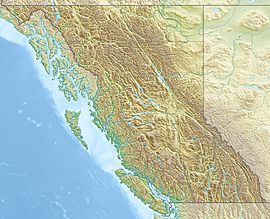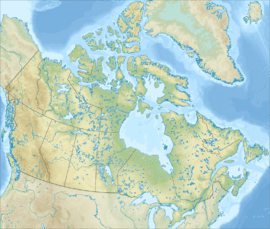Mount Bayard facts for kids
Quick facts for kids Mount Bayard |
|
|---|---|
| Boundary Peak 15 | |

Mount Bayard and Salmon Glacier
|
|
| Highest point | |
| Elevation | 1,999 m (6,558 ft) |
| Prominence | 189 m (620 ft) |
| Parent peak | Mount Lindeborg (2109 m) |
| Geography | |
| Location | British Columbia, Canada |
| Parent range | Boundary Ranges Coast Mountains |
| Topo map | NTS 104B/01 |
Mount Bayard is a tall mountain, about 1,999 metres (6,558 ft) high. It is covered in ice and snow, which means it's a glaciated mountain. This mountain sits right on the border between Canada (in British Columbia) and the United States (in Alaska).
You can find Mount Bayard about 22 kilometres (14 mi) north-northwest of a town called Stewart. It's also near other mountains like Mount White-Fraser and Mount Lindeborg. Water from the melting ice and snow on Mount Bayard flows into the Salmon River. This river is fed by the Boundary and Salmon Glaciers that surround the mountain.
About Mount Bayard
Mount Bayard is part of the Boundary Ranges, which are a section of the larger Coast Mountains. It's a significant peak because it marks part of the international boundary line. The mountain is sometimes called Boundary Peak 15. If the weather is clear, you might even see Mount Bayard from the Granduc Mine Road near Hyder, Alaska.
How Mount Bayard Got Its Name
The mountain was first named Mount Lindeborg in 1921. But by 1924, its name was changed to Mount Bayard. The name Mount Lindeborg was then given to a different peak nearby.
Mount Bayard was named by the International Boundary Commission. They chose the name to honor Thomas F. Bayard (1828-1898). He was an important American diplomat and a United States Senator. A diplomat is someone who represents their country in talks with other countries. The name was officially accepted on July 31, 1927, by the Geographical Names Board of Canada.
Weather at Mount Bayard
Mount Bayard is in a region with a marine west coast climate. This means it gets a lot of rain and snow. Most of the weather systems come from the Pacific Ocean. As these systems move east, they hit the tall Coast Mountains. The mountains force the air upward, which makes the moisture fall as rain or heavy snowfall.
Because of this, the Coast Mountains, including Mount Bayard, get a lot of precipitation. This is especially true in winter when most of it falls as snow. Temperatures can get very cold, sometimes dropping below −20 °C. With the wind, it can feel even colder, below −30 °C.




